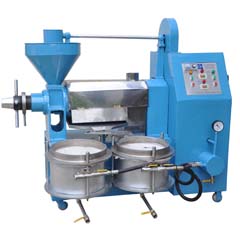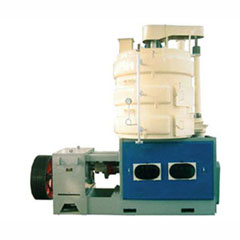
Cottonseed Oil Press
Cottonseed oil is a cooking oil extracted from the seeds of cotton plant. Cotton grown for oil extraction is one of the big four genetically modified crops grown around the world, next to soy, corn, and rapeseed (canola).
The cottonseed has a similar structure to other oilseeds such as sunflower seed, having an oil bearing kernel surrounded by a hard outer hull. In processing, the oil is extracted from the kernel. Cottonseed oil is used for salad oil, mayonnaise, salad dressing, and similar products because of its flavor stability. The cottonseed oil undergoes intensive treatment after extraction to reduce the level of gossypol found in untreated cottonseed oil, the consumption of which may produce undesirable side-effects.

Cottonseed Oil Press

Cottonseed Oil Press
The Method of Cottonseed Oil Production / Cottonseed Oil Press / Cottonseed Oil Extraction
1. Broiling: general pot put 1 / 4 to 1 / 3 of capacity, will become so uniform, Qin pointed out repeatedly and thoroughly, fire can not be too large, so as to avoid shell-fat coke. After the cottonseed in the slot Grilled fried flat stick barrel, so that the steam heat dissipation, cooling after the clean-up easy to sift.
2. Sieving: The manual or fixed screen sieve screens out dirt and impurities.
3. Grinding: grinding nowadays less material to absorb rather than drying up, mill speed appropriately fast, so that cottonseed easily broken.
4. Add water: With the grinding roll ring groove watering of milling, the side of the sprinkler, one side turned seeds, so that blank draft uniform, consistent milling about grinding 20 minutes, until the thin blank not a group.
5. Steamed blank: powder blanks into the steam drum to be hand-Pa-ping, so that steam drums breathe evenly, billet temperature, moisture consistent. Such as the steam drum at the end of Shau Kei back cylindrical-shaped, heat evenly, keeping the water level steamer, steam and water barrels at the end of the distance of 16 cm and over, light a fire to be uniform.
6. Package cake: package cake should have a decentralized packet cake, to be fast, to be packaged flat tight, to focus on the pressing and fast. Single-lap pizza, a thickness of 2 cm or so after the press should try to shorten the time to prevent the billet in the heat dissipation.
7. Pressing: virgin when the cake right now, adjust the distance from the circle and circle to avoid uneven playing cake. Plus tip, it is necessary not a line up until the oil flow. When the oil line off, and then pressing 2 hours in order to loose air squeezed.
8. To clarify filter: squeeze out a lot of impurities in crude oil. Should be quickly cooled, put it aside for a period of time to filter, so as not to color deepened to increase the refining loss.
Chemical Composition of Cottonseed Oil
Its fatty acid profile generally consists of 70% unsaturated fatty acids including 18% monounsaturated (oleic), 52% polyunsaturated (linoleic) and 26% saturated (primarily palmitic and stearic).[4]
Cottonseed oil is described by scientists as being "naturally hydrogenated" because the saturated fatty acids it contains are the natural oleic, palmitic, and stearic acids. These fatty acids make it a stable frying oil without the need for additional processing or the formation of trans fatty acids . Cottonseed oil is not required to be as fully hydrogenated for many purposes as some of the more polyunsaturated oils. On partial hydrogenation, the amounts of monounsaturated fatty acids actually increase. When hydrogenated to a typical Iodine Value of about 80, for example, its fatty acid profile shifts to 50% monounsaturated, 21% polyunsaturated, and 29% saturated, which are all well within current diet/health guidelines.
Gossypol is a biologically-active yellow polyphenolic compound produced by cotton and other members of the order Malvaceae, such as okra. This coloured compound found in tiny glands in the seeds, leaf, stem, tap root bark, and root of the cotton plant. The adaptive function of the compound is believed to be one of facilitating insect resistance.
The three key steps of refining, bleaching and deodorization that are involved in producing finished oil act to reduce the gossypol level. Ferric chloride is often used to decolorize cottonseed oil.